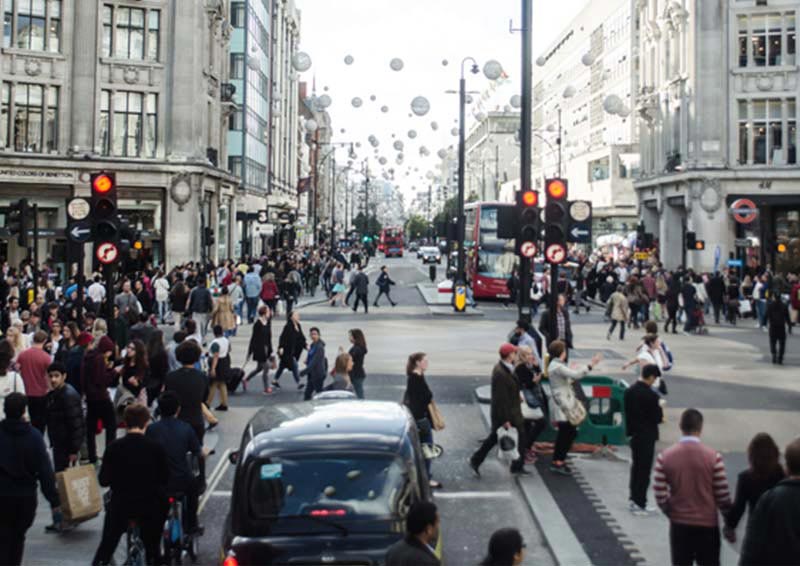People flow
People flow is relatively new term used to describe the movement of pedestrians in different environments under different circumstances and at different scales. The term has perhaps historically been used to refer to the transit of populations between different geographical regions, but has now come to be used also in the context of urban planning, public space and the urban realm as well as circulation within or between buildings.
Whilst the term is less common in formal dictionaries, IGI Global a leading independent academic publisher of scientific research defines the term as "a physical quantity representing the number of people passing through a certain passage per unit time".
An industry perhaps considered as one of the proponents of the term are manufacturers of vertical transport systems such as elevators, lifts or escalators. Increasing the efficiency of such systems relies on an understanding of how occupants move around buildings of more than one levels, but also within individual levels.
In terms of the urban planning people flow might be used synonymously or as a derivation of pedestrian flow, footfall, walkshed, or circulation. It describes how people move around spaces, access areas, interact and occupy those areas, externally and internally.
Within buildings it can be important to know, for example which way people tend to turn when they walk into a shop. It can also be useful in evacuation planning.
As accessibility, security as well as observation technology within cities and buildings increases, the term may also be used in connection with barriers, mobility, public infrasructure, thermal imaging, CCTV, observation, face recognition and Smart cities.
The development of mobile devices has made it easier to track people flow, for example by offering free wifi, the terms and conditions of which allow operators to record subscriber's locations.
[edit] Related articles on Designing Buildings
- 15 minute city.
- Built environment.
- Cycling and walking plan.
- Designing for pedestrians.
- Desire lines.
- Space syntax.
- Pedestrian amenity
- Pedestrian priority street
- Pedestrian zone
- Pedestrianised.
- Psychogeography.
- Public space.
- Walking distance.
- Hub and spoke model.
- Landscape urbanism.
- Pedestrian..
[edit] External links
Featured articles and news
Retired firefighter cycles world to raise Grenfell funds
Leaving on 14 June 2025 Stephen will raise money for youth and schools through the Grenfell Foundation.
Key points for construction at a glance with industry reactions.
Functionality, visibility and sustainability
The simpler approach to specification.
Architects, architecture, buildings, and inspiration in film
The close ties between makers and the movies, with our long list of suggested viewing.
SELECT three-point plan for action issued to MSPs
Call for Scottish regulation, green skills and recognition of electrotechnical industry as part of a manifesto for Scottish Parliamentary elections.
UCEM becomes the University of the Built Environment
Major milestone in its 106-year history, follows recent merger with London School of Architecture (LSE).
Professional practical experience for Architects in training
The long process to transform the nature of education and professional practical experience in the Architecture profession following recent reports.
A people-first approach to retrofit
Moving away from the destructive paradigm of fabric-first.
International Electrician Day, 10 June 2025
Celebrating the role of electrical engineers from André-Marie Amperè, today and for the future.
New guide for clients launched at Houses of Parliament
'There has never been a more important time for clients to step up and ...ask the right questions'
The impact of recycled slate tiles
Innovation across the decades.
EPC changes for existing buildings
Changes and their context as the new RdSAP methodology comes into use from 15 June.
Skills England publishes Sector skills needs assessments
Priority areas relating to the built environment highlighted and described in brief.
BSRIA HVAC Market Watch - May 2025 Edition
Heat Pump Market Outlook: Policy, Performance & Refrigerant Trends for 2025–2028.
Committing to EDI in construction with CIOB
Built Environment professional bodies deepen commitment to EDI with two new signatories: CIAT and CICES.
Government Grenfell progress report at a glance
Line by line recomendation overview, with links to more details.
An engaging and lively review of his professional life.
Sustainable heating for listed buildings
A problem that needs to be approached intelligently.
50th Golden anniversary ECA Edmundson apprentice award
Deadline for entries has been extended to Friday 27 June, so don't miss out!
CIAT at the London Festival of Architecture
Designing for Everyone: Breaking Barriers in Inclusive Architecture.
Mixed reactions to apprenticeship and skills reform 2025
A 'welcome shift' for some and a 'backwards step' for others.





























Comments
[edit] To make a comment about this article, or to suggest changes, click 'Add a comment' above. Separate your comments from any existing comments by inserting a horizontal line.